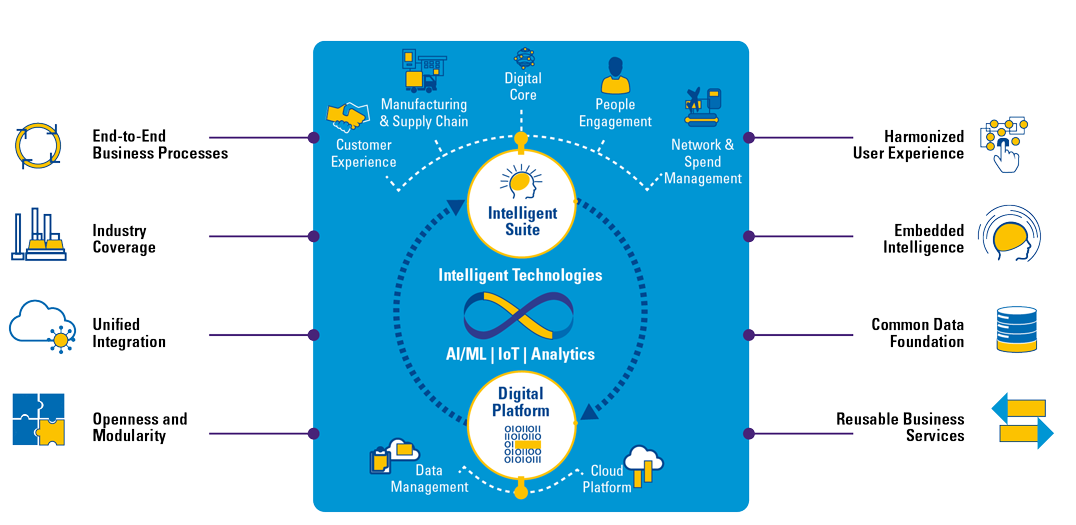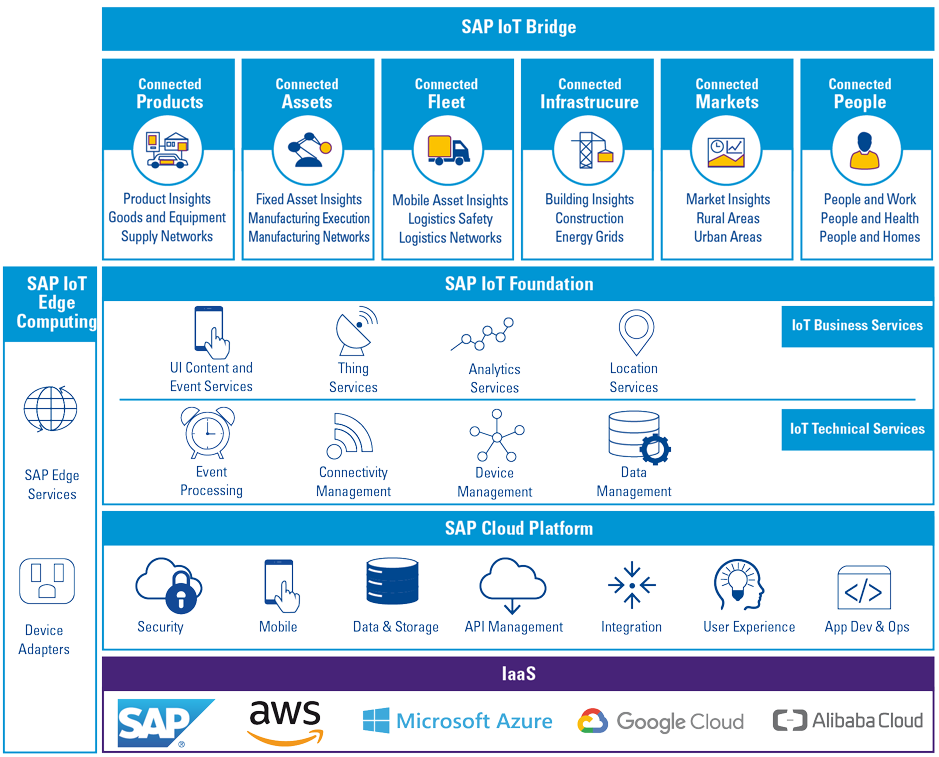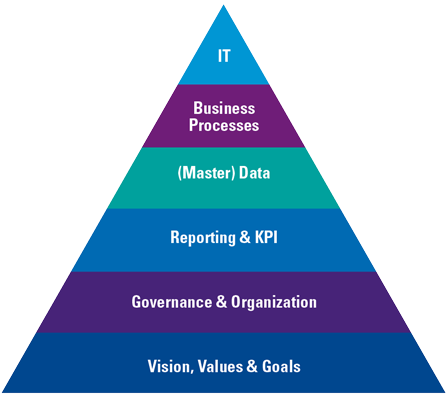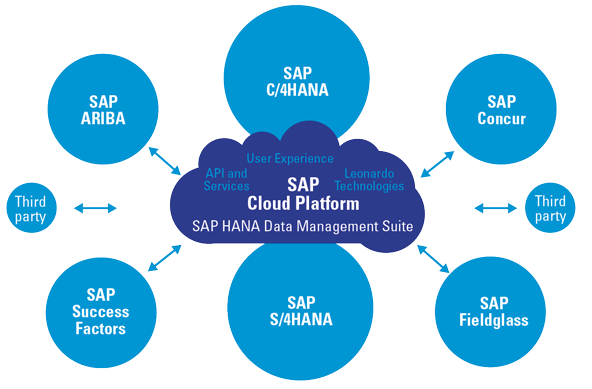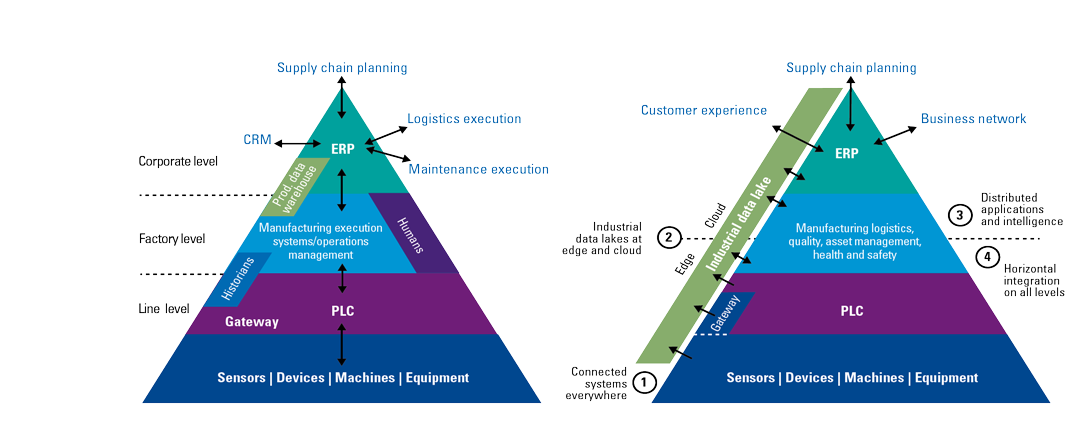To benefit from the increasing availability of smart digital technologies and their positive impact on customer demand, behaviour and expectations, there is a strong need to realize a fully connected, intelligent enterprise that is highly focused on customer centricity and operational excellence. In this article we will explore how these developments impact your current ERP landscape and broader operating model, what specific SAP solutions are offered, and we will share attention points for realizing the connected, intelligent enterprise.
The connected, intelligent enterprise
We are currently living in the “age of the customer”, a term coined by Forrester to indicate the increasing empowerment of customers and the shift of buying power. This is highly driven by advances in technology and it heavily impacts the way businesses have to operate and deliver. It is important that organizations can anticipate quickly within this dynamic and demanding customer environment where customer experience is key. Organizations need to be able to providing services in flexible ways (Omni channel), products in personalized ways (lot size of one) and deliver products and services quickly and efficiently. New business models may even arise to create extra opportunities or to stay relevant. To realize this change there is no quick solution like adding a simple “smart technology add-on” and you are ready to go. It requires an enterprise-wide transformation that goes beyond technology and includes changes to your operating model. This impacts functions and processes (e.g. how we manage product- and service lifecycles, how we produce and deliver, how we sell and interact with customers), it impacts how we integrate and collaborate with other parties and within our own organization as it impacts our governance, data, systems and IT infrastructure.
This enterprise transformation, also referred to as digital transformation, is key for success and will result in what we refer to as the “connected enterprise” or the “intelligent enterprise”. Intelligent enterprise is also the name used by SAP to refer to businesses that have embedded the use of advanced technologies in their organization. We will use both terms in this article as they perfectly cover the two main characteristics of the new organization – being connected and being intelligent.
- “Connected” emphasizes the increased focus on networks, collaboration and integration both in the organization as with external parties. It also refers to the Internet of Things (IoT) where an increasing number of smart objects is connected and provides us data, thereby linking the physical world to the digital world and providing various new ways to create insights, boost performance and create value.
- “Intelligent” refers to the data-driven approach where advances in technology, such as IoT, Artificial Intelligence (AI) and Machine Learning (ML), are used to collect and process large volumes of data and use this to create intelligent processes and empower users. Intelligent processes contain a high level of automation and incorporate smart machines that can sense the environment and act upon it.
The starting point for both “connected” and “intelligent” is the use of advances in technology and the way these are embedded within the organization through digital transformation. Realizing this successfully requires changes on multiple levels. We will briefly explore these in this article. We will also show the major SAP solutions for realizing connected, intelligent enterprises and share some attention points.
Smart technologies and the fourth industrial revolution
Advances in technology have resulted in the “age of the customer”. This provides many new opportunities but is also quite a challenge. Fortunately, the same advances in technology have also brought forward the fourth industrial revolution. As a quick refresher: the first revolution was about mechanization using water and steam power, the second revolution about assembly lines and mass production using electricity, and the third revolution was about automation and digitization through the use of information technology. The fourth industrial revolution builds further on this and is all about connections and networks (e.g. between people, processes and devices) and the extensive use of data from these connections to create a seamless customer interaction, boost performance through better insights, improved (autonomous) decision-making and even via new business models. This fourth industrial revolution is primarily made possible by using IoT, cyber-physical systems (CPS), Cloud and Edge computing, and various intelligence technologies such as Big Data, ML, and AI.
Compared to the previous revolutions, the fourth industrial revolution is not so much about introducing new technologies as such, but more about the emerging of existing technologies due to improved availability, affordability, and new practical use cases to apply and combine these technologies. For example, while the foundation of IoT may have been around for some time, the increased availability of cheap sensors and cheap connectivity, the rise of 5G, the use of new internet protocols such as IPv6, and better availability of big data storage/analytical systems have fueled the use of IoT.
The fourth industrial revolution is probably best known in the shape of Industry 4.0 where it transforms the way that products are manufactured and the supply chain is managed. This is realized by embedding smart technologies and the use of data-driven approaches to be able to deal with highly dynamic and specific customer demand. Industry 4.0 is a relevant topic nowadays and companies are in different stages of their transformation towards this. In our thought paper Beyond The Hype – Separating Ambition From Reality in Industry 4.0 ([Gate17]) you can read what other companies are doing regarding Industry 4.0 and what they learned from this.
Next to specific Industry 4.0 purposes, embedding smart technologies is also a key enabler to realize customer centricity. This relies heavily on data and it will be clear that IoT and data intelligence solutions such as AI, ML, and Big Data are key to realizing this. Typical examples are consumer IoT (e.g. smart wearables) and commercial IoT (e.g. smart cities). Both have in common that sensor data is used to track customer behavior that can be used to more effectively design, differentiate and tailor products to the (individual) customer demand and to be able to offer value added services.
So we are in the age of the customer, where customer centricity is key, and we need a connected, intelligent enterprise that is driven by the technologies of the fourth industrial revolution to be able to cope with highly dynamic customer demand. That is quite something and it might be obvious already that having a traditional Enterprise Resource Planning (ERP) landscape as such is not enough. Let’s explore this further.
Beyond ERP
The world of smart technologies differs in many perspectives from traditional IT like ERP with a key difference being that ERP is a system of records. ERP is not about speed and innovation, but about robustness, integrity and providing a solid foundation for your end-to-end business processes and providing operational and financial insights. ERP and related systems such as Customer Relationship Management (CRM) or Supplier Relationship Management (SRM) are the cornerstone of the business and, if set up properly, contain the relevant data to be able to manage the business using the relevant insights. Value could typically be gained by improving the ERP landscape itself, for example by consolidating multiple ERP systems in one ERP system via a OneCompany approach.
The above was sufficient for the third industrial revolution as the main focus was on increasing productivity, computerization of process steps and most importantly having end-to-end integration and single source of truth for business processes and related (master) data. With the fourth industrial revolution, things are quite different. The above is still applicable and important, but value does not exclusively come from ERP anymore. High connectivity and the availability of (large volumes of) data are key themes. Organizations need intelligent solutions to be able to use these to their advantage to stay relevant and keep up with the dynamics of today’s markets. ERP is still the cornerstone of the business, but it is no longer sufficient.
- Take data. If you look at Gartner, they refer to the 3Vs – volume, variety, and velocity – as the three defining properties or dimensions of (big) data. Volume refers to the amount of data, variety refers to the number of types of data and velocity refers to the speed of data processing. We primarily had to deal with transactional data from ERP and (some) data from third parties that were linked to our business processes. In the new era, the data footprint increases exponentially across all three properties. Think of using unstructured data and the vast amount of data that comes from smart objects through IoT.
- Take connectivity. From an ERP perspective, connectivity was mainly about interfacing with other applications or parties to share data/documents. Integration was mostly about end-to-end process and data integration, which was covered by the integrated nature of ERP. The fourth industrial revolution goes way beyond connectivity and integration. Think of increasing levels of horizontal and vertical integration (also refer to the text box on page 24) and due to smart technologies, such as Blockchain and IoT, we see new ways of collaboration between parties as well as a strong convergence of operational technology (e.g. machines and devices) and information technology (e.g. applications) that brings the physical and digital world closer together.
To cover all of this, an intelligent ecosystem is needed where the traditional systems of record are combined with the use of emerging technologies to create the connected, intelligent enterprise. From a technology view this is done by realizing a digital platform and integrating this with your current ERP application landscape. Figure 1 shows how this is visualized by SAP. It shows the two main components: the “intelligent suite” (ERP and related systems) and the digital platform (including SAP Cloud Platform). Together they are labeled by SAP as “business technology platform” and ensure that intelligent technologies can be embedded to provide the necessary intelligence.
Figure 1. SAP Business Technology Platform (source: SAP). [Click on the image for a larger image]
Digital platform and SAP Cloud Platform
The starting point of the connected, intelligent enterprise is an organization that is highly connected and data driven. The digital platform makes this happen as it is essentially an integration, development and data management, processing and analysis “toolkit”. It provides relevant (micro)services and applications that are needed to make necessary connections and integrations internally and externally, to obtain and process data from various physical and digital sources (including business applications) and to use smart technologies to analyze and translate data into meaningful business insights and trigger business actions.
Value is typically gained when these business insights are embedded into your business processes and related applications like ERP, CRM and Manufacturing Execution System (MES). It can boost your performance by reducing the amount of human intervention and by empowering users by providing them with better, actionable insights to do their work. Next to the integration with your existing business applications, the digital platform can also be used to develop your own innovative applications and dashboards that can be used to support your business processes. Alternatively, there is also an increasing number of standard apps that come with these digital platforms.
You can setup your own (on-premises) digital platform. However, it is often more practical and cheaper to use Platform-as-a-Service (PaaS), such as Microsoft Azure, Google Cloud and the example used in this article, SAP Cloud Platform (SCP). It typically reduces the IT administration effort and end users can easily access the data, apps and (micro)services from any place through the Internet. The PaaS from SAP is the in-memory based SAP Cloud Platform (SCP). Figure 2 shows the digital platform architecture using SAP Cloud Platform (SCP) as a basis. In this case the example is for using IoT. The choice for IoT is just to illustrate, a similar architecture is used for other intelligent solutions on SCP. Note that the SAP solutions have gone through some recent name changes, refer to text box “Branding” for further insights.
Figure 2. SAP IoT architecture with SAP Cloud Platform (source: SAP). [Click on the image for a larger image]
Branding
SAP solutions are rebranded every once in a while, and the domain of the intelligent enterprise is no exception. This is key to exploring SAP solutions and collecting information. The SAP Cloud Platform (SCP) was initially named “SAP HANA Platform” or “SAP HANA Cloud Platform” but HANA was taken out of the name to emphasize a broader perspective of the digital platform. Another key name change is “SAP Leonardo”. This was used as the overarching name for the digital platform (SCP), the intelligent technologies (e.g. AI, ML, Big Data, IoT) and the methodology to implement these (design-led thinking). Recently, the name Leonardo has been dropped to focus more on the solutions itself. For example, SAP Leonardo IoT is renamed SAP IoT. In the same way we now talk about SAP Machine Learning, SAP Blockchain, etc. Finally, the technology layer to support the intelligent enterprise (business applications and digital platform) combined is indicated with the “business technology platform”.
Let’s take a brief look at the various layers of the SCP-based digital platform starting from the bottom.
- The SAP Cloud Platform runs on IaaS. This can be done via SAP’s own data centers, but in practice SCP often runs on IaaS from any hyperscaler. This is partly due to SAP’s move to a more open standard and “freedom of choice” concept, which also supports the shift of SCP running on their proprietary Neo environment to the industry standard Cloud Foundry. This has the advantage that you are no longer bound to using SAP proprietary services, which in practice means that the digital platform will not necessarily contain components from just one vendor, but a hybrid solution with services from multiple vendors is possible. Some factors to consider when selecting the right (combination of) platforms are the offered services maturity, development facilities, authentication and authorization methods and license fees (especially on indirect access to SAP). In an SAP-based application landscape, the realization of a digital platform using SCP can bring some advantages, such as native integration, but a clear strategy is needed to set up the overall platform.
- The SCP layer and SAP IoT foundation layer contain the technical functionality and (micro)services for the digital platform. Typical examples as shown in Figure 2 are data and device management, API management, application development and analytics services. The SCP and foundation layer use standard protocols. For example, it facilitates device management through the use of standard communication protocols to deal with communication amongst heterogeneous smart devices. Another example is the use of standard data management and processing protocols. This ensures the ability to connect, analyze, govern, secure, and share data that is retrieved from smart devices. When using standard data management and data processing protocols, interoperability issues are addressed, and smart devices have a basis for communication and data exchange. Lastly, the connection to several heterogeneous smart technologies and an increased number of interconnections with other partners creates a potential security risk; they form new potential entry points for hackers. Therefore, security also plays an important role in these layers and should be a high priority right from the start.
- On top of the services layers the digital platform has various (standard) applications and dashboards to embed data-driven insights in your business (processes). In Figure 2 these are referred to as the SAP IoT Bridge. SAP categorized their IoT related apps and dashboards in Connected Products, Connected Fleets, Connected Assets, etc. to emphasize their view on the various use cases with IoT. Note that the overview of apps is a mix of already available apps and apps that are part of the IoT roadmap for future releases.
- Especially for IoT, the Edge Computing layer is one of the main components. The volume of data coming from IoT devices is typically way too high to process it all in the central storage. Also, sensors do not always have the capacity to efficiently transfer data to this central storage. Edge computing allows data to be processed on devices closer to the source itself, referred to as gateways, and so data can be processed locally, resulting in faster response times and saving of bandwidth. SAP supports Edge via SAP Edge Services and SAP Dynamic Edge Processing. Obviously, Edge Computing as such is not part of the SCP, but the coordination and integration with these Edge gateways is. Networking characteristics need to be taken into account when defining your strategy for adopting smart technologies and determines amongst others the extent to which Edge Computing should be used. Think of range, network bandwidth and power usage.
This is only a high-level exploration of the digital platform but should give a basic idea of how these combined layers will help to embed the use of smart technologies into your business domains. And how this can help realize the connected, intelligent enterprise that enables customer centricity and more business agility.
Impact on ERP and operating model
You have to realize that establishing the connected, intelligent enterprise is not only about technology but also about transforming your broader operating model and probably your business model. Let’s have a look at each of these using the structure shown in Figure 3. This “information pyramid” visualizes how your business model and underlying vision, values and goals are used as a foundation for your operating model. Each layer in the pyramid supports the layers below and provides the guiding principles for the layers above. We will explore these layers in reverse order starting at the top with IT (ERP/SAP) and related SAP solutions.
Figure 3. Information pyramid (source: KPMG). [Click on the image for a larger image]
IT (ERP/SAP)
From an ERP perspective, the realization of the connected, intelligent enterprise is mostly about making necessary integrations with the digital platform and through the digital platform with other parties and “things”. In this way data from ERP and related business applications can be used as input for gaining relevant insights and vice versa insights gained with the digital platform are used to trigger automated and autonomous business actions within the business processes. Also end users of the business applications are empowered to make better decisions and have better information through these business insights.
In Figure 1 the ERP landscape is referred to as the “Intelligent Suite” , which includes ERP and the related applications that cover specific functionality in various business domains. The “Digital Core”, named this way by SAP to emphasize this is about the key business processes, is the ERP system. In the intelligent enterprise this ERP system typically is SAP S/4HANA, the successor of SAP ECC, optimized to work with SAP HANA technology. SAP HANA is key in the intelligent enterprise. Please refer to text box “SAP HANA” for further guidance. Being so key, each organization should have a clear strategy when and how to migrate their current ERP landscape to SAP HANA and move to SAP S/4HANA. The support for SAP ECC will stop by the end of 2027 (or under conditions by the end of 2030). This is quite far away, but if you want to fully and quickly utilize the full potential of the intelligent enterprise, an earlier migration could be quite beneficial.
SAP HANA
SAP HANA is key for the connected, intelligent enterprise. HANA is the in-memory database management system developed by SAP to use advances in technology (such as multi-core processing, big memory, optimized cache) to offer a different way of storing, processing and using (large volumes of) data for transactions, reports and analytics. The starting point is that data is handled much faster, which benefits transactional processing (e.g. faster MRP), provides better insights (e.g. real-time reporting) and enables innovation through the digital platform (e.g. IoT, AI, ML). SAP HANA technology is used for both the applications and the digital platform and is truly the enabler technology of the SAP-based intelligent enterprise. For example, one of the reasons data can be handled much faster is that due to HANA the data model of the SAP ERP system was highly simplified, for example by getting rid of aggregated tables and index tables. Also, making connections is easier compared to ECC due to the improved API management for S/4HANA.
The ERP landscape does not only include the ERP application as such, but it also refers to other (mostly SaaS) applications that provide functionality in specific business domains. For example, Ariba for Procurement, SuccessFactors for HR and C/4HANA for marketing and sales. As shown in Figure 4, from an SAP view the digital platform is the linking pin to integrate these applications and ensure a central layer to be able to use intelligent technologies and data-driven insights across all business domains. Think of providing a real-time 360 view of the customer which is key for customer centricity. Note that SAP is heavily pushing the HANA-based Cloud (SaaS) solutions in favor of the classic on-premise Business Suite solutions such as SAP CRM, HCM and SRM. These legacy solutions can run on SAP HANA but are not optimized for HANA and they are not native SaaS. It is key to having a clear vision on your overall business application landscape, including the use of on-premise versus Cloud and the role of the digital platform.
Figure 4. SAP Cloud Platform as linking pin (source: SAP). [Click on the image for a larger image]
The key principle for a future-proof intelligent landscape is to keep business applications, and especially the ERP core, as standard as possible. Using too many custom developments and too many process variants and system configuration variants makes the application landscape unnecessary complex. Obviously, this complexity does not help when you have to update your system and will at least require a lot of unnecessary effort and risk. You also have to realize that although technically it is possible to connect a digital platform to even the worst configured ERP core, the resulting “insights” might be questionable at best. Given the importance to keep the core as clean as possible, additional functionality is developed outside the core, for example as an application on the digital platform. There is a reason why ERP SaaS, like S/4 Cloud, gets more popular because standardization is a key principle of these solutions.
Business processes
Embedding smart technologies and the resulting business insights in your business processes is of fundamental importance to realize the connected, intelligent enterprise. To do this, these business processes and the way they are supported by ERP change in several ways. The most direct change is the increased level of process automation and autonomous decision-making. Although typically relevant to Industry 4.0 processes (e.g. supply chain, manufacturing), this concept can be applied to generally all business domains. This automation is partly set up within ERP itself but will mostly be triggered by specific events or insights generated on the digital platform.
Next, one of the aspects of the connected, intelligent enterprise is the empowerment of users so they can perform process steps more efficiently and decision-making is improved. This can only be done by providing users with better insights that are real-time, user-friendly, fit-for-purpose and actionable. The ERP system should be able to process data fast and process data from different sources to provide the relevant insights. From an SAP perspective, this is why HANA is so important and the integration of ERP with the Cloud platform, to provide the insights via ERP or directly via an app or dashboard on the Cloud platform.
Another attention point is the impact of integration. Please refer to the text box “Horizontal & vertical integration” for an explanation. Both have a major impact on your business processes as they extend a process and available insights beyond specific domains, functions and/or organizational boundaries. This integration requires that process flows and information flows are integrated with these other entities and parties. For this to be successful, complexity needs to be reduced as much as possible. Similar to the fundament of having a clean ERP core, business processes should not contain any unnecessary complexity either. If we need to work on the same processes and work with the same data across entities and across the supply chain, these processes should be set up the same way. A good way to improve processes is to use the ESSA approach. ESSA is an acronym for Elimination, Simplification, Standardization and Automation. Successful process automation and autonomous decision-making relies upon simple and standard, harmonized processes. This also fits the trend to use SAP S/4HANA Cloud Edition, where the level of customization is limited by nature and you need to adhere to the standard, best practice processes.
Horizontal & vertical integration
Horizontal and vertical integration are key pillars of the connected, intelligent enterprise as it ensures processes and related data can flow between relevant levels of the organization and between internal and external parties.
Figure 5. Example of vertical integration with Industry 4.0 (source: SAP). [Click on the image for a larger image]
Vertical Integration: refers to the integration across different hierarchical layers inside the organization. A typical Industry 4.0 example is the integration between production line level, factory level and corporate level and related systems such as PLC, MES and ERP. See Figure 5, that is provided by SAP, that shows the traditional and new architecture where the “industrial data lake” represents the availability of data (and related insights) across the various levels.
Horizontal integration: refers to the integration of similar functions within the organization or outside the organization. Within the organization, integration can take place within or between divisions. Integration of production machines into a production network within a shop floor is an example of integration within divisions, while integration of multiple production facilities is an example of integration across divisions. Outside the traditional organizational boundaries, horizontal integration refers to integration within the supply chain, such as supplier, customers, manufacturers. The traditional linear process of make, sell, buy, and use products or services becomes distributed among the different actors in the supply chain.
(Master) Data
From an organizational perspective, the increased level of horizontal and vertical integration require that master data and transactional data are distributed timely and correctly across the various functions and parties involved. Correct data and timely availability of data is also of increasing importance for decision-making that is highly based on insights resulting from these data flows. Especially with the increased automation of process steps and the use of autonomous decision-making by machines the correctness of underlying data is key.
To be able to provide business insights to the end-users in a timely manner, the ERP system and digital platform should be able to store and process data fast, not just from ERP (and related systems) but from various sources. From an SAP perspective, this is again why HANA is key. This technology provides the relevant techniques (such as in-memory and better hardware) and made it possible to simplify the S/4HANA data model compared to the SAP ECC data model. This makes it easier to use the data. The insights also need to be presented in a user-friendly way. This requires the earlier mentioned improvements in human-machine interaction. From an SAP perspective concepts such as SAP Fiori support the way users interact within business processes.
Embedding smart technologies requires a balancing act between central and decentral data management. Smart technology devices create large amounts of (un)structured data. Dealing with the parameters of volume, velocity, and variety of data can be challenging. Using a digital platform can be useful to manage and integrate data from a variety of sources. Traditionally, the main idea of an ERP system represents a centralized instance to manage and execute business processes. A centralized instance remains to play a pivotal role when adopting smart technologies. Think of master data, such as vendor data which will be managed centrally to avoid inconsistencies. To increase flexibility, however, data derived from smart technologies can be stored decentral. The speed of data access is important to enable workers to make decisions based on the latest available data. Immediate data access can become challenging when decision-making data is stored decentral.
Data sharing inside and outside your organization becomes more important. Due to horizontal integration, data is exchanged with other partners in the ecosystems. ERP uses interfaces with these (external) parties. To successfully exchange data outside your organization, it is crucial to agree on data formats and protocols to avoid inconsistencies. Furthermore, your current ERP system should be technically capable to integrate with other partners. Due to vertical integration, data should be able to flow freely (bi-directional) between various functions in your organization and their related systems (e.g. between ERP – MES – PLC systems or between S/4HANA – C/4HANA – web shop layers). In both examples, vertical integration needs to improve the flexibility of your business processes to be able to react quickly to customer behavior.
Standardization and simplification is also key for (master) data. This enables easier data exchange and more reliable results when using these data for business insights and related decision-making. Given the typical number of applications in a given landscape, it is of fundamental importance to unify and harmonize data models across the organization. It will be obvious that an effective and efficient master data management function with clear data governance is key for realizing this.
Reporting & KPI
The connected, intelligent enterprise, if set up properly, can process an almost unlimited amount of data from a variety of physical and digital sources. Using smart technologies, this data can be processed and analyzed in many ways and turned into business insights. These can then be presented in numerous user-friendly means to all relevant parties involved in your end-to-end business processes and functions on various levels of decision-making. However, it will be clear that it can be very challenging to identify what data is actually valuable to deliver insights that support realization of the value proposition, productivity gains and customer-centricity objectives. Organizations should spend time and effort to define which insights (and underlying data) are actually important, and which KPIs are business critical. Allocating this is key in the realization of a successful digital transformation. Part of this reporting strategy should be standardization of reports and KPIs which are shared and supported inside and outside your organization.
Analytical tools become of more importance to turn the variety of data into business insights. Data is increasingly being analyzed in real-time, which is challenging for traditional analytical tools. From an SAP perspective, the SAP Analytics Cloud (SAC) solution plays an important role in the intelligent enterprise. Starting point for SAC is to provide a flexible environment for reporting and analytics and by integrating with the SCP, smart technologies can also be used to process data and generate insights.
Governance & Organization
Due to the increased amount of process automation and autonomous decision-making in the connected, intelligent enterprise in many situations the type of employee that is needed will change. Repetitive tasks will often be automated, and users increasingly focus on coordination and decision-making based on provided business insights. Organizations will need to train their employees to become data literate, to be able to read, work with, analyze and argue with data. Data experts and business leaders will work together to optimize insights and drive change.
Regarding user interfaces, a key characteristic of the intelligent applications is the focus on user-friendliness. This means access to “easy to use” applications, a friendly user interface, use of mobile devices to interact, etc. SAP offers SAP Fiori to provide this user experience. An increasing number of standard SAP Fiori apps are made available that cover dashboards, transactions, etc. But you can also maintain your own SAP Fiori apps. With increasing horizontal and vertical integration, business processes tend to stretch outside functions and entities. This automatically means that ownership needs to be clearly defined and might change compared to the current situation.
With the introduction of heterogeneous smart technologies that need to communicate with each other, organizations aim for high interoperability to maximize the potential of smart technologies. At the same time the expanding integration with parties and between devices will demand strict governance to ensure integrity of the entire ecosystem. The role of the IT function will also get more important. This was already triggered in the third industrial revolution which led to more automation. However, in order to realize the connected, intelligent enterprise, the IT function will have to work even more closely with the business to link the use of IT to clear business objectives and practical solutions.
Vision, values and goals
The vision layer is the foundation for all other layers. This layer is not actually part of the operating model but provides the guiding principles for the operating model. It emphasizes the need to have a clear business strategy and business model with clear objectives on how the company will make use of digital technologies improving overall performance of the business, creating a higher customer satisfaction, becoming more customer-centric and while doing so, lowering operational costs. This could mean a decision to change the business model to stay relevant to customer expectations. In practice, we see many implementations of smart technologies for the sake of using smart technologies. These projects often do not yet deliver substantial performance gains.
Final notes
The connected, intelligent enterprise is key to staying relevant and successful in the age of the customer. Smart technologies that emerged with the fourth industrial revolution will support in realizing this. Based on increased connectivity and a highly data-driven approach, digital platforms, such as SCP, are used to extend existing ERP landscapes to enable customer-centricity and boost business agility and operational excellence. To implement this, technology as such it not sufficient. Broader changes are needed on all levels of the operating model. Standardization and simplification principles are key when defining this future operating model. Better practices are a good way to do this. SAP provides better practices via their SAP model companies and predefined process flows. KPMG provides the global Powered Enterprise© toolkit that contains better practice content for all layers of the operating model including a standard approach to realize the business transformation. Ultimately, the operating model should support a clear business strategy and (possibly revised) business model that takes into account the challenges and opportunities that come with the age of the customer.
Reference
[Gate17] Gates, D. & Bremicker, M. (2017). Beyond the hype – Separating ambition from reality in Industry 4.0. KPMG International. Retrieved from: https://home.kpmg/content/dam/kpmg/xx/pdf/2017/05/beyond-the-hype-separating-ambition-from-reality-in-i4.0.pdf







